- Benefits of Growing Honeysuckle from Seeds
- Choosing the Right Type of Honeysuckle
- 1. Flower Color
- 2. Growth Habit
- 3. Fragrance
- 4. Disease Resistance
- 5. Climate Suitability
- Common Varieties of Honeysuckle
- How to Plant Honeysuckle Seeds
- Caring for Honeysuckle Plants
- Watering
- Pruning
- Fertilizing
- Support
- Pest and Disease Control
- Winter Care
- Regular Maintenance
- Common Problems and Solutions for Honeysuckle
- Powdery Mildew
- Aphid Infestation
- Yellowing Leaves
- Poor Flowering
- Root Rot
- Questions and Answers:
- What is honeysuckle?
- Can honeysuckle be grown from seeds?
- How do you grow honeysuckle from seeds?
- What are some popular types of honeysuckle?
- How long does honeysuckle take to flower?
- Can honeysuckle be grown in containers?
- Videos: How to Make Easy and Cheap Trellis
If you are a fan of fragrant, colorful flowers and want to add a touch of elegance to your garden, then honeysuckle might be the perfect choice for you. Honeysuckle plants are known for their beautiful flowers and delightful scent that can fill your garden with a sweet aroma. In this ultimate guide, we will take you through the process of growing honeysuckle from seeds, exploring the different types and varieties available.
Why grow honeysuckle from seeds?
While honeysuckle can be propagated through cuttings or layering, growing them from seeds can be a rewarding and exciting experience. By planting honeysuckle seeds, you have the opportunity to witness the entire growth cycle of this beautiful plant, from a tiny seed to a fully blooming vine. It also allows you to experiment with different varieties and explore the colors and fragrances they offer.
“Honeysuckle plants are not only beautiful but also attract a variety of pollinators, including bees and butterflies. By growing honeysuckle in your garden, you can create a haven for these beneficial insects and contribute to creating a more sustainable ecosystem.”
Types and varieties of honeysuckle
Honeysuckle comes in different types and varieties, each with its unique characteristics and charms. The most common types include Lonicera japonica, Lonicera periclymenum, Lonicera sempervirens, and Lonicera ciliosa. Each type offers a range of varieties with varying colors, flower shapes, and fragrances.
Whether you prefer the classic Japanese honeysuckle with its white and yellow flowers or the native trumpet honeysuckle with its vibrant red or orange tubular blooms, there is a honeysuckle variety to suit every taste and garden style. Some varieties even have edible flowers and berries, adding an extra dimension to your garden, both aesthetically and gastronomically.
In this ultimate guide to growing honeysuckle from seeds, we will provide you with all the necessary steps, tips, and tricks to ensure your success in cultivating these stunning plants. So, get ready to embark on a horticultural adventure and bring the beauty and fragrance of honeysuckle to your garden!
Benefits of Growing Honeysuckle from Seeds
There are several benefits to growing honeysuckle from seeds, including:
- Cost-effective: Growing honeysuckle from seeds is a cost-effective way to add the plant to your garden. Seeds are generally more affordable than buying established plants or seedlings.
- Variety: By growing honeysuckle from seeds, you have a wide variety of options to choose from. There are different cultivars and varieties available, each with their own unique colors, fragrances, and growth habits.
- Control: Growing honeysuckle from seeds gives you better control over the growth and development of the plant. You can ensure that it is started in optimal conditions and monitor its progress from the very beginning.
- Satisfaction: Watching a honeysuckle grow from a tiny seedling into a thriving plant can be an incredibly rewarding experience. It allows you to witness the entire life cycle of the plant, from germination to flowering.
- Long-term investment: While growing honeysuckle from seeds may take some time and patience, it is a long-term investment. Once established, honeysuckle plants can provide years of beauty, fragrance, and wildlife benefits to your garden.
Overall, growing honeysuckle from seeds allows you to have more control and variety in your garden, all while being cost-effective and satisfying.
Choosing the Right Type of Honeysuckle
When it comes to choosing the right type of honeysuckle, you have a wide range of options to consider. Different varieties of honeysuckle offer unique characteristics, such as flower colors, growth habits, and fragrances. Here are some factors to consider when selecting the right type of honeysuckle for your garden:
1. Flower Color
Honeysuckle comes in a variety of flower colors, including white, pink, red, yellow, and orange. Consider what colors will complement your existing garden and personal preferences. For example, a yellow honeysuckle may stand out against a backdrop of green foliage, while a red variety may add a vibrant splash of color.
2. Growth Habit
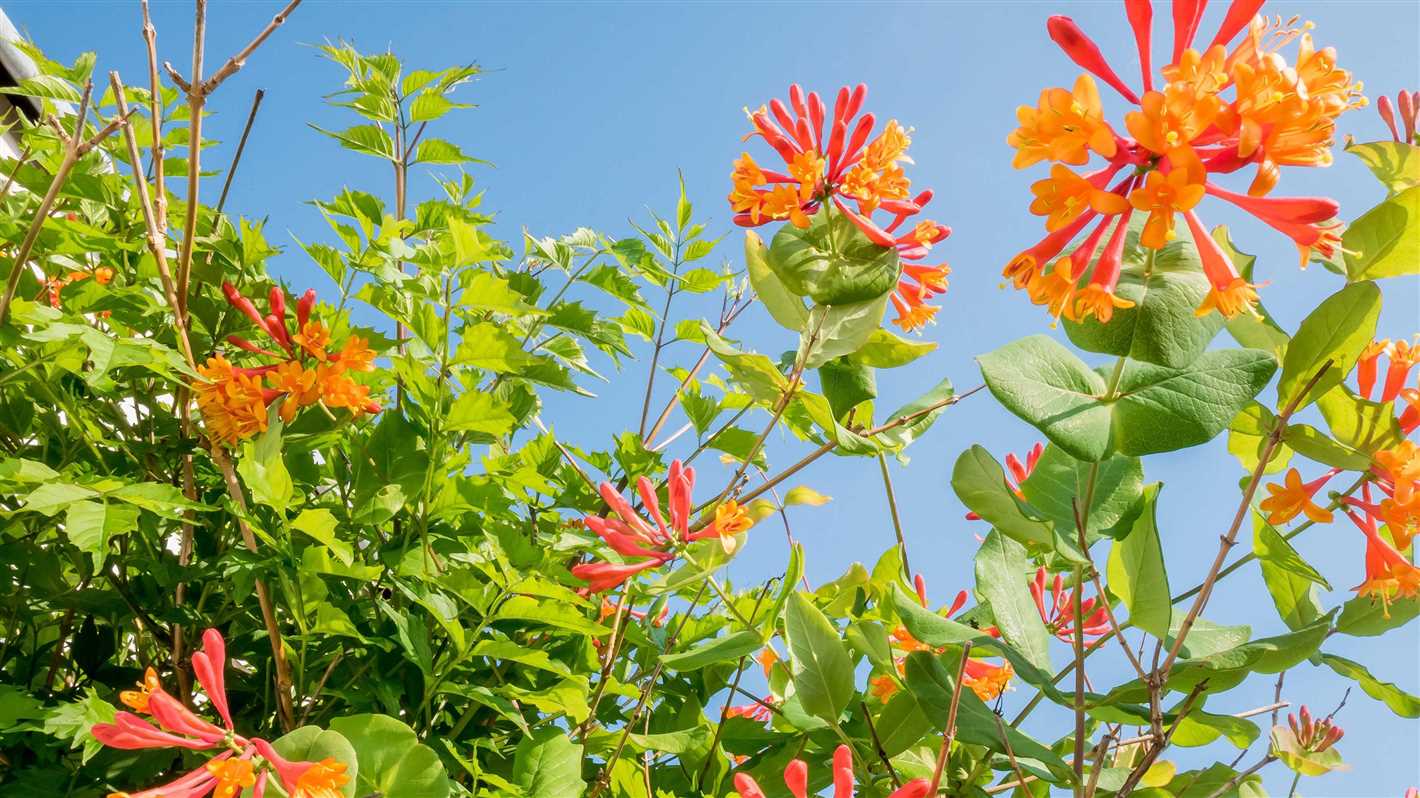
Some honeysuckle varieties are climbers, while others are shrubs or groundcovers. Consider the available space in your garden and the desired effect you want to achieve. Climbing varieties can be trained to grow on trellises, fences, or walls, while shrub forms are better suited for borders or hedging.
3. Fragrance
Honeysuckle is known for its sweet fragrance that attracts birds, bees, and butterflies. Some varieties have a stronger fragrance than others. Consider whether you want a highly scented variety to enjoy the delicate aroma in your garden.
4. Disease Resistance
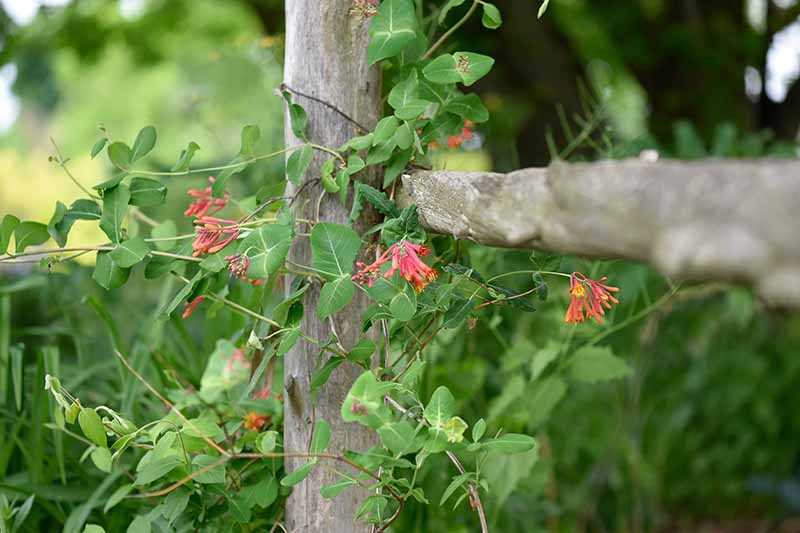
Some types of honeysuckle are more resistant to diseases and pests than others. If you prefer low-maintenance plants, look for varieties that are known for their resilience and resistance to common issues like powdery mildew or aphids.
5. Climate Suitability

Certain types of honeysuckle are better suited to specific climates. Consider the temperature range and growing conditions in your area to ensure that the honeysuckle variety you choose will thrive.
By considering these factors, you can make an informed decision and choose the right type of honeysuckle that will enhance the beauty of your garden and meet your specific preferences and needs.
Common Varieties of Honeysuckle
Honeysuckle plants are known for their beautiful, fragrant flowers and their ability to attract hummingbirds and butterflies. There are many different varieties of honeysuckle, each with its own unique characteristics and growing requirements. Here are some of the most common varieties of honeysuckle:
Japanese Honeysuckle (Lonicera japonica):
Japanese honeysuckle is a fast-growing vine that is native to eastern Asia. It has white or yellow flowers that give off a sweet fragrance. It is highly invasive in many parts of the world and can quickly take over an area if not properly managed.
Trumpet Honeysuckle (Lonicera sempervirens):
Trumpet honeysuckle is a native vine in the United States. It has bright red or orange tubular flowers that are extremely attractive to hummingbirds. It is more compact than other honeysuckle varieties and is well suited for smaller gardens.
Goldflame Honeysuckle (Lonicera x heckrottii ‘Goldflame’):
Goldflame honeysuckle is a hybrid variety that has reddish-orange flowers that fade to yellow as they age. Its foliage is a mix of green and burgundy, making it an attractive plant even when not in bloom. It is a vigorous grower and will quickly cover a trellis or fence.
Dropmore Scarlet Honeysuckle (Lonicera x brownii ‘Dropmore Scarlet’):
Dropmore Scarlet honeysuckle is a hardy vine with bright red flowers. It blooms from late spring to early summer and attracts hummingbirds and butterflies. It is a vigorous grower and can reach heights of 10 to 15 feet.
These are just a few examples of the many varieties of honeysuckle available. When choosing a honeysuckle plant for your garden, consider factors such as its growth habit, flower color, and fragrance, as well as its native range and its suitability to your specific climate and soil conditions.
How to Plant Honeysuckle Seeds
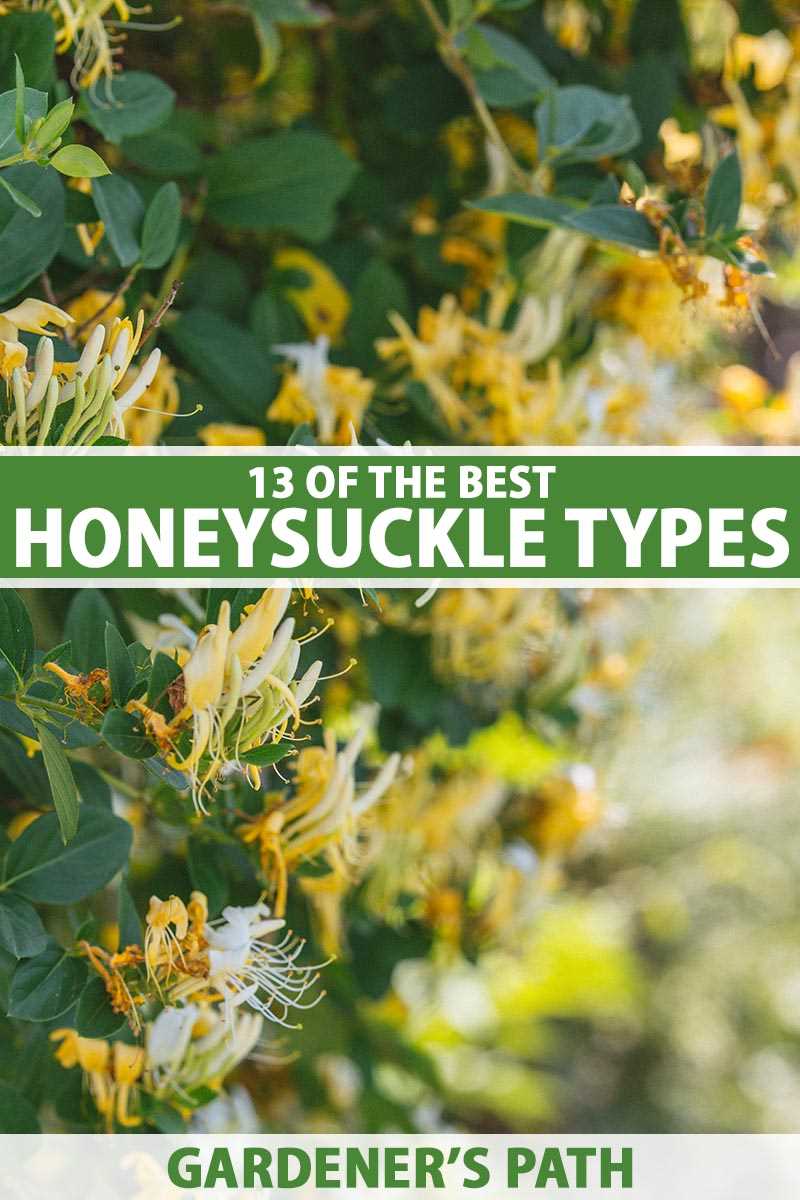
Planting honeysuckle seeds is a simple and rewarding process. Here are the steps to follow:
- Prepare the soil: Choose a well-draining location for planting the honeysuckle seeds. Loosen the soil and remove any weeds or debris.
- Soak the seeds: Place the honeysuckle seeds in a container filled with warm water and let them soak overnight. This will help to soften the seed coat and improve germination.
- Sow the seeds: After soaking, sow the seeds directly into the prepared soil. Plant them about 1/4 inch deep and 6 inches apart. If you are planting multiple seeds, space them about 2 feet apart to allow for adequate growth.
- Water the seeds: After sowing the seeds, gently water the soil to ensure it is moist but not saturated. Keep the soil consistently moist throughout the germination process.
- Provide sun and shade: Honeysuckle plants prefer full sun to partial shade. Choose a location that receives at least 6 hours of direct sunlight per day.
- Maintain the plants: Once the seeds germinate and the plants start growing, ensure they receive regular water and fertilizer. Mulching around the plants can help retain moisture and keep weeds at bay.
- Train the vines: As the honeysuckle plants grow, provide them with support structures such as trellises or pergolas. Train the vines to climb up the structures for optimal growth and aesthetics.
- Prune as needed: Prune the honeysuckle plants in late winter or early spring to remove any dead or overcrowded branches. This will promote healthy growth and blooming.
- Enjoy the blooms: Honeysuckle plants usually start blooming in their second or third year. Sit back and enjoy the fragrant and vibrant flowers that attract pollinators to your garden.
By following these steps, you can successfully plant honeysuckle seeds and enjoy the beauty and fragrance of this lovely plant in your own garden.
Caring for Honeysuckle Plants
Watering
Honeysuckle plants need regular watering, especially during the hot summer months. Keep the soil evenly moist, but avoid overwatering as it can lead to root rot. Water deeply and thoroughly, allowing the water to penetrate the roots.
Pruning
Honeysuckle plants benefit from regular pruning to maintain their shape and promote healthy growth. Prune in early spring before new growth emerges or after flowering has finished. Remove dead or damaged branches, as well as any crossed or crowded branches. Pruning also helps to control the size of the plant and prevent it from becoming too invasive.
Fertilizing
Apply a balanced, slow-release fertilizer in early spring to provide essential nutrients for the honeysuckle plant. Follow the instructions on the fertilizer package for appropriate application rates. Avoid over-fertilizing, as it can lead to excessive vegetative growth instead of blooms.
Support
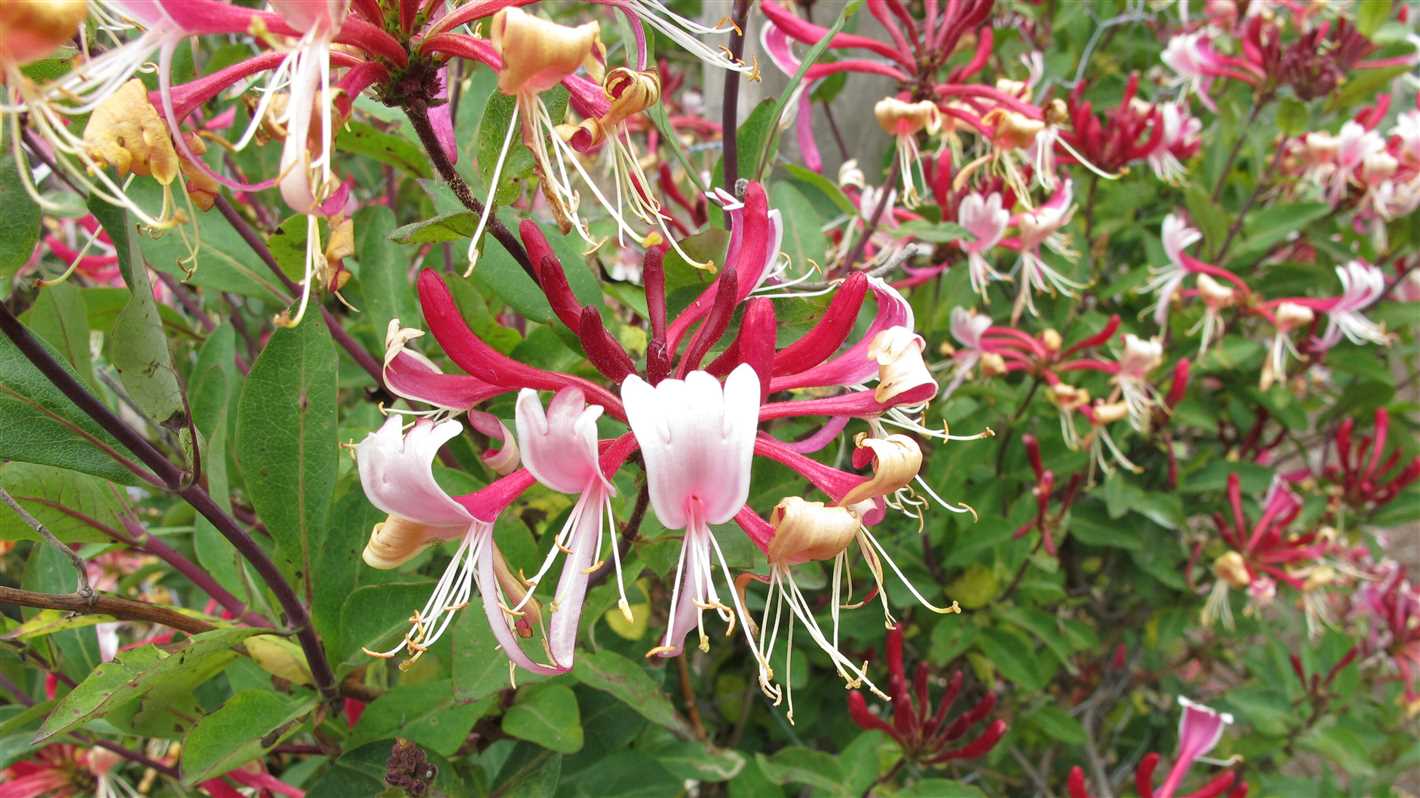
Most honeysuckle plants are climbers and need support to grow upwards. Install a trellis or other vertical structure for the plant to twine around. Make sure the support is sturdy and can withstand the weight of the plant as it grows. Regularly check the support structure and adjust as necessary to prevent damage or collapse.
Pest and Disease Control
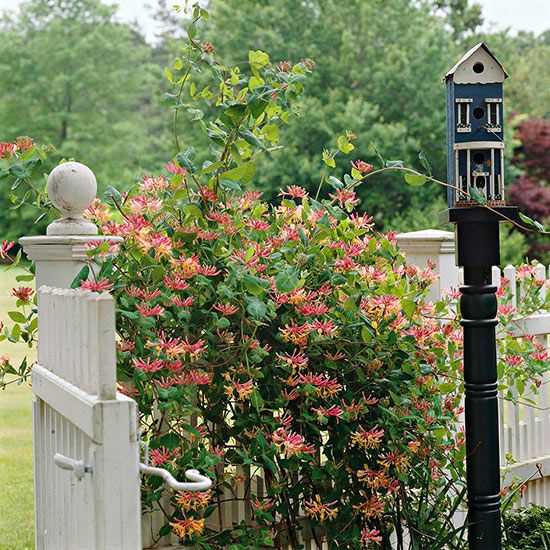
Monitor honeysuckle plants for common pests such as aphids, spider mites, and scale insects. If necessary, use horticultural oil or insecticidal soap to control these pests. In terms of diseases, honeysuckle plants are generally resistant, but they can be susceptible to powdery mildew. Prune out any infected branches and ensure good air circulation around the plant to prevent fungal diseases.
Winter Care
Some honeysuckle varieties are hardy and can withstand colder temperatures, while others may require protection during winter. Mulch around the base of the plant to insulate the roots and provide protection from frost. If necessary, consider covering the plant with burlap or other protective materials to shield it from extreme cold and drying winds.
Regular Maintenance
Lastly, regular monitoring and maintenance are essential for the healthy growth of honeysuckle plants. Remove weeds around the plant to reduce competition for nutrients and water. Check for any signs of stress, disease, or pest infestation, and take appropriate action promptly to prevent further damage. Regularly deadhead faded flowers to encourage continuous blooming.
Common Problems and Solutions for Honeysuckle
Powdery Mildew
Powdery mildew is a fungal disease that commonly affects honeysuckle plants. It appears as a white powdery substance on the leaves, stems, and flowers of the plant. To prevent and treat powdery mildew, follow these solutions:
- Prune the honeysuckle to improve air circulation and reduce humidity around the plant.
- Avoid overhead watering, as the moisture on the leaves can promote powdery mildew growth.
- Apply a fungicide specifically formulated to treat powdery mildew. Follow the instructions on the product label.
- Remove and dispose of any infected plant material to prevent the spread of the disease.
Aphid Infestation
Aphids are small, sap-sucking insects that feed on the sap of honeysuckle plants. They can cause stunted growth, curled leaves, and the presence of sticky honeydew on the plant. To control aphid infestations, try the following solutions:
- Spray the honeysuckle plant with a strong stream of water to dislodge the aphids.
- Introduce natural predators of aphids, such as ladybugs or lacewings, to the garden.
- Apply an insecticidal soap or neem oil spray to kill the aphids. Follow the instructions on the product label.
- Prune heavily infested areas and dispose of the affected plant material to prevent further infestation.
Yellowing Leaves
Yellowing leaves on honeysuckle plants can be caused by various factors, including nutrient deficiencies, overwatering, or inadequate sunlight. To address this issue, consider the following solutions:
- Ensure the honeysuckle plant is receiving sufficient sunlight. Most varieties require at least 6 hours of direct sunlight per day.
- Adjust the watering schedule to avoid overwatering. Honeysuckle plants prefer a slightly moist, well-draining soil.
- Test the soil for nutrient deficiencies and amend accordingly. Honeysuckles generally benefit from a balanced fertilizer application in early spring.
- Inspect the plant for signs of pests or diseases that may be causing the yellowing leaves. Treat any issues accordingly.
Poor Flowering
If your honeysuckle plant is not producing many flowers, there are a few potential causes and solutions to consider:
- Ensure the honeysuckle is receiving adequate sunlight. Insufficient sunlight can inhibit flower production.
- Prune the plant to promote new growth and encourage flower bud formation.
- Check for nutrient deficiencies and make sure the plant is receiving the necessary nutrients for healthy flower production.
- Consider the age of the plant. Some honeysuckle varieties may take a few years to become established and start blooming prolifically.
Root Rot
Root rot is a common problem in honeysuckle plants caused by overwatering or poorly drained soil. It can lead to wilting, yellowing leaves, and eventually plant death. To address root rot, follow these solutions:
- Improve soil drainage by adding organic matter, such as compost, to the planting area.
- Avoid overwatering and allow the soil to dry slightly between watering sessions.
- Consider transplanting the honeysuckle to a new location with better soil drainage if root rot persists.
- Remove and destroy any severely affected plant parts to prevent the spread of the disease.
| Problem | Solution |
|---|---|
| Powdery Mildew | Prune, improve air circulation, avoid overhead watering, apply fungicide, remove infected material. |
| Aphid Infestation | Spray with water, introduce predators, apply insecticidal soap or neem oil, prune and dispose of infested areas. |
| Yellowing Leaves | Ensure sufficient sunlight, adjust watering, test soil for nutrients, inspect for pests and diseases. |
| Poor Flowering | Provide adequate sunlight, prune, check for nutrient deficiencies, consider plant age. |
| Root Rot | Improve soil drainage, avoid overwatering, consider transplanting, remove affected plant parts. |
Questions and Answers:
What is honeysuckle?
Honeysuckle is a flowering plant that belongs to the Caprifoliaceae family. It is known for its fragrant and colorful flowers.
Can honeysuckle be grown from seeds?
Yes, honeysuckle can be grown from seeds. However, it may take several years for the plant to bloom when grown from seeds.
How do you grow honeysuckle from seeds?
To grow honeysuckle from seeds, start by scarifying the seeds, which involves scratching the seed coat to allow water to penetrate. Then, soak the seeds in warm water for 24 hours. After that, sow the seeds in a pot filled with moist soil, and place the pot in a warm and sunny location. Keep the soil moist, and the seeds will germinate within a few weeks.
What are some popular types of honeysuckle?
Some popular types of honeysuckle include the Japanese honeysuckle, the trumpet honeysuckle, and the goldflame honeysuckle. Each type has its own unique characteristics and flower colors.
How long does honeysuckle take to flower?
The time it takes for honeysuckle to flower varies depending on the type and growing conditions. Generally, it takes about 2 to 3 years for honeysuckle grown from seeds to reach maturity and start flowering.
Can honeysuckle be grown in containers?
Yes, honeysuckle can be grown in containers. Choose a compact variety of honeysuckle and use a large container with good drainage. Make sure to provide support for the plant to climb, and place the container in a sunny location. Regular watering and fertilizing are necessary for the plant to thrive in a container.







